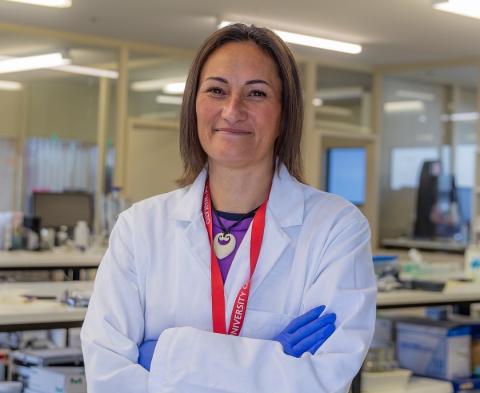
Marine biologist Kiri Reihana says urgent action is required to save the tuangi (cockle) population in Ōhiwa Harbour in the eastern Bay of Plenty.
Kiri (Ngāpuhi, Te Rarawa, Ngāi Tūhoe, Whakatohea) is a NPM PhD scholar who is using mātauranga Māori to improve co-management practices in the harbour. Prior to starting her research, there was limited data on the state of tuangi in Ōhiwa. While locals had been reporting sharp declines in the number and size of tuangi since the 1990s, there was a dearth of empirical data to support their reports.
Kiri interviewed kaumātua who collected tuangi during their youth, analysed monitoring information from the Bay of Plenty Regional Council then surveyed and mapped all the cockle beds in the Ngāti Awa region. From this she produced a deeper analysis of the state of the tuangi population.
Unfortunately, the news was all bad. The legal minimum size for harvesting tuangi is 30mm. Kiri’s research found few cockles exist over that size and haven’t existed in large numbers for over 30 years. “In the ‘80’s our people were saying populations were declining and cockles were too small to take, but there hasn’t been enough thorough research to test this. My research tells us the population of tuangi is at a crisis point and something needs to be done to save it from extinction,” she says.
Kiri is now at the point of presenting her research back to iwi who will need to develop their own recommendations for ways to help tuangi thrive once again. Tuangi are a taonga species for Ngāti Awa, Whakatōhea and Ngai Tūhoe - all who have governance over the Ōhiwa Harbour - along with the two district councils and the Bay of Plenty Regional Council. Kiri’s research will play a critical role in allowing them to make decisions about tuangi management.
Kiri is now preparing publications for her PhD study. One paper looks at how government legislation has impacted the ability of Māori to interact with the marine environment. She says legislation has been pivotal in excluding Māori economically from the marine environment, beginning with the introduction of the 1866 Oysters Fisheries Act. Kiri says the Act was created to encourage oyster farming production in Aotearoa but it also impeded the ability of Māori to enact rangatiratanga in marine commerce. “The effects of this legislation impacted Māori hugely for the coming generations, and it was no different from being displaced from our whenua,” says Kiri.
She says it wasn’t until the 1980s, with the success of the Ngāi Tahu claim (WAI 27) and the Muriwhenua fishing claim (WAI 22), that Māori could begin to secure their rights to economic benefits from the marine environment. “This kind of research is as important as collecting data and doing hands-on research in the water, because it challenges colonial power dynamics that have been working to marginalize Māori. It is important to keep scrutinizing all legislation coming through to push back when it marginalizes Māori rights,” she says.
Kiri, who has degrees in architecture as well as marine biology, also plans to visually present her findings to make it easier for whānau to understand what is happening to tuangi. At the start of her PhD Kiri was diagnosed with dyslexia and she says the diagnosis affirmed why visual communication is her super strength. She plans to put this strength to good use, creating graphs, maps, and models for use by iwi and local councils.
“Tuangi occupy different niche spaces in the harbour and depending on their age, they require different types of water characteristics to survive. I have created a range of maps, models and graphs to create more robust research reflective of our results,” she says.
Kiri is based at the University of Waikato Coastal Marine Field Station and says being part of a research team that is interested in creating practical solutions to problems is the best part of her job. “Impact science is where we are at. We do it at the ground, we survey, we constantly engage with whānau. There is no point in having high level theories when they don’t work practically and where people are not part of finding solutions,” she says.
“I love my job because it is impactful, and it is working with our people of all ages. We need to tap into our kaumātua as a resource and we need to stand beside our young ones as they learn to protect our environment. Our young ones are innately connected to the harbour. It sparks me, and you can see it sparking them too when you take them out to work beside you.”